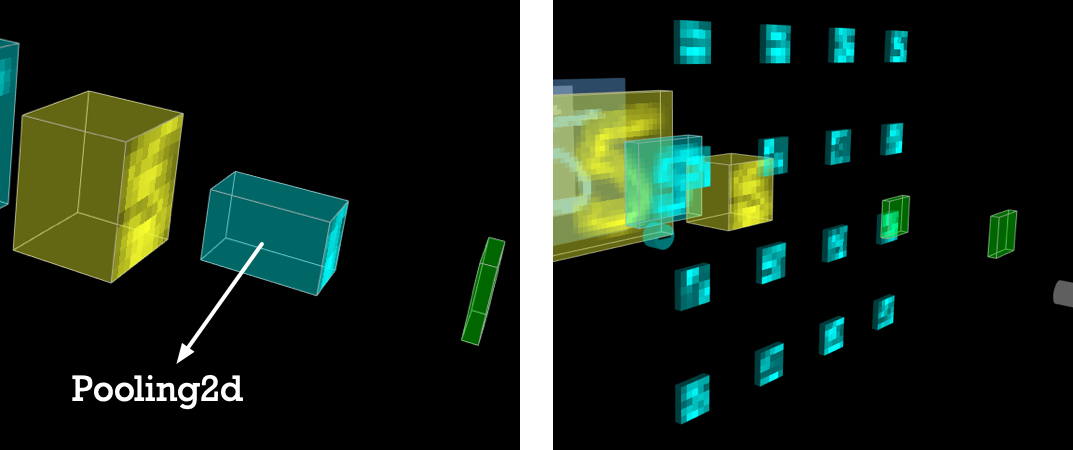2D pooling. MaxPooling2d and AveragePooling2d
only change the calculate method not the structure of the model, so they both use this API.
Constructor
Based on whether TensorSpace Model load a pre-trained model before
initialization, configure Layer in different ways. Checkout Layer
Configuration documentation for more information about the basic configuration rules.
〔Case 1〕If TensorSpace Model has loaded a pre-trained model before
initialization,
there is no need to configure network model related parameters.
TSP.layers.Pooling2d();〔Case 2〕If there is no pre-trained model before initialization, it is
required to configure network model related parameters.
Two methods to create a new layer. Arguments are required.
[Method 1] Use poolSize and strides

TSP.layers.Pooling2d( { poolSize : Int , strides: Int } );[Method 2] Use shape
TSP.layers.Pooling2d( { shape : [ Int, Int, Int ] } );
Fig. 1 - Pooling2d layer close and open
Arguments
Name Tag |
Type |
Instruction |
Usage Notes and Examples |
|---|---|---|---|
|
poolSize |
Int[] | Shape of pooling windows | poolSize: [ 2, 3 ] Width is 2 and height is 3 |
|
strides |
Int[] | The strides of the pooling windows | strides = [ 1, 2 ] Transverse step 1, longitudinal step 2 |
|
name |
String | Name of the layer | For example, name: "layerName" In Sequential Model: Highly recommend to add a name attribute to make it easier to get Layer object from model. In Functional Model: It is required to configure name attribute for TensorSpace Layer, and the name should be the same as the name of corresponding Layer in pre-trained model. |
|
padding |
String | Padding mode, Network Model Related |
valid[default]: Without padding. It drops the right-most columns (or bottom-most rows). same: With padding. Output size is the same as input size. |
|
shape |
Int[] | Output shape, Network Model Related |
For example, shape: [ 28, 28, 6 ] means the output is 3-dimensional, 6 feature maps and each one is 28 by 28. Data format is channel last. |
|
color |
Color Format | Color of layer | Pooling2d's default color is light blue #00FFFF |
|
closeButton |
Dict | Close button appearance control dict. More about close button | display: Bool. true[default] Show button, false Hide button ratio: Int. Times to close button's normal size, default is 1, for example, set ratio to be 2, close button will become twice the normal size |
|
initStatus |
String | Layer initial status. Open or Close. More about Layer initial Status | close[default]: Closed at beginning, open: Open at beginning |
|
animeTime |
Int | The speed of open and close animation | For example, animeTime: 2000 means the animation time will last 2 seconds. Note: Configure animeTime in a specific layer will override model's animeTime configuration. |
Properties
.inputShape : Int[]
filter_center_focusThe shape of input tensor, for
example inputShape = [ 28, 28, 3 ] represents 3 feature maps and each
one is 28 by 28.
filter_center_focusAfter model.init()
data is
available, otherwise is undefined.
.outputShape : Int[]
filter_center_focusThe shape of output tensor is
3-dimensional. 3️⃣
filter_center_focusdataFormat is channel last. for
example outputShape = [ 14, 14, 3 ] represents the output of this layer
has 3 feature maps and each one
is 14 by 14.
filter_center_focusAfter model.init()
data is
available, otherwise is undefined.
.neuralValue : Float[]
filter_center_focusThe intermediate raw data after
this
layer.
filter_center_focusAfter load and model.predict() data
is available, otherwise is undefined.
.name : String
filter_center_focusThe customized name of this
layer.
filter_center_focusOnce created, you can get it.
.layerType : String
filter_center_focusType of this layer, return a
constant: string Pooling2d.
filter_center_focusOnce created, you can get it.
Methods
.apply( previous_layer ) : void
filter_center_focusLink this layer to previous layer.
filter_center_focusThis method can be use to
construct
topology in Functional Model.
filter_center_focus See Construct Topology for more details.
.openLayer() : void
filter_center_focus Open Layer, if layer is already
in
"open" status, the layer will keep open.
filter_center_focus See Layer Status for more details.
.closeLayer() : void
filter_center_focus Close Layer, if layer is
already in
"close" status, the layer will keep close.
filter_center_focus See Layer Status for more details.
Examples
filter_center_focus If TensorSpace Model load a
pre-trained model before initialization, there is no need to configure network model related parameters.
let poolingLayer = new TSP.layers.Pooling2d( {
// Recommend Configuration. Required for TensorSpace Functional Model.
name: "Pooling2d1",
// Optional Configuration.
animeTime: 4000,
initStatus: "open"
} );filter_center_focus If there is no pre-trained
model
before initialization, it is required to configure network model related parameters.
let poolingLayer = new TSP.layers.Pooling2d( {
// Required network model related Configuration.
poolingSize: [ 2, 3 ],
strides: [ 2, 2 ],
// Recommend Configuration. Required for TensorSpace Functional Model.
name: "Pooling2d2",
// Optional Configuration.
animeTime: 4000,
initStatus: "open"
} );Use Case
When you add pooling layer with Keras | TensorFlow | tfjs in your model the corresponding API is
Pooling2d
in TensorSpace.
| Framework | Documentation |
|---|---|
| Keras | keras.layers.MaxPooling2D(pool_size=(2,2)) |
| TensorFlow | tf.layers.max_pooling2d( inputs, pool_size, strides) |
| TensorFlow.js | tf.layers.maxPooling2d (config) |
Source Code



